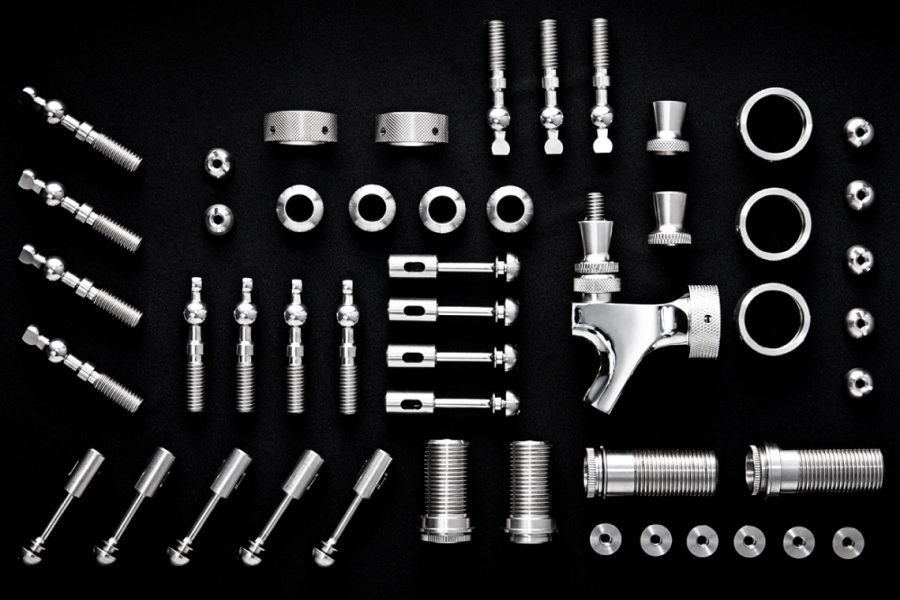Every single CNC machinist that knows about his craft is knowledgeable about the tools used in the trade. In the world of CNC machining, however, there is a lot of tools that only the most celebrated experts know how to use. CNC is a procedure commonly used by many manufacturing industries, but it’s a passion for many enthusiasts who love to create something from scratch.
CNC machining probably looks mundane and even dull even to the most avid entrepreneur, but for some people learning about this is the difference between succeeding or failing on their business initiatives. Most innovations in the manufacturing industry come from someone realizing how problematic and tedious a task can be, and it made a mission to optimize it.

CNC machining parts*
The following is a list of devices used by CNC machining experts across the internet. Some of these tools are used to help you deal with particular problems, such as work holding and fixtures. Others can help you fix tool setups and any issues with coolant nozzles. Please take a moment of your time to read about them.
Tools to Handle Fixture Building and Work Holding
Work holding is a term used to refer to the tools used to hold things in place. Some of the most common are fixture clamps, vacuum plates, pallets, pliers, or anything that it’s helpful to make you have a tight grip wherever you need it. Vise jaws are included in this group as well since they can help you deal with round fixtures and parts that are oddly shaped for any given reason. There is a lot of work holding products out there that are primed to work with very small pieces, especially for 5-axis CNC machines, since they often use very different arrangements in their tooling. Dovetail fixtures are a hot commodity used for single parts applications.
There are industrial setups that can help you deal with multiples parts at once as well. Some of the most quality-proven tools are the ones used on zero-point clamping systems. They require more massive vise jaws for wider grips that are handled using nontraditional methods to locate a workpiece without using mechanical stomps. This would allow the technician to handle the part with crimps and hydraulic fixtures to be aligned with serrated saws on the tooling head. Speaking of jaws, you can also work with new and improved vise jaws that are equipped with extremely hardened pins that can be pushed, pulled, and located where it’s deemed fit to do so.
Tools to Handle Parts and Setups
Some of the most popular setup aids can help you manage touch-off devices. You can also center a boring bar on a lathe, tram the head of a port mil and use vise stops. You will find these stationary and mechanical, so don’t worry too much about the options. One of the most popular items for setups is magnetic-level attachments that can help you handle the tap and keep it straight when you are doing hand-tapping tasks.
Tool Shop Resources You Can Buy and Use at Home
We understand that as an enthusiast, you probably want to try out the latest manufacturing technology at home. The good news is that there is a lot of technology that can help your creative mind and function properly in your garage. The bad news is that the latest technology only works at industrial levels, and only when it becomes affordable, it makes the transition to small scale production. These days you can buy CNC laser machines that can be mounted in collets or tool holders. They even come equipped with a guidance system in the form of a laser pointer. You can also buy clamps and lathe turrets to position your workpiece and save the work of counting serrations.
Tools to Handle Coolant Nozzles
Coolant nozzles are used to cool down your product once it’s been machined. They deliver water or other coolant solution to make sure you get a clean finish, and the shape of the products remain intact. You will need grinders, screw machines, and a lot of manual tools to set them up. Coolant nozzles itself need to be mounted for every specific task and calibrated using CAD/CAM software. A lot of companies are offering cooling systems that resemble the structure of a spider. This product is often perceived as a fix for old school machines that have a problematic distribution of the coolant systems.
Keep in mind that there are a lot of companies offering these products at different prices. An expensive piece of equipment is not always synonymous with quality. You have a lot of homework to do to learn about the best brands of tools offered in the market. You will also need to learn about the functionality of each one. In the end, it’s all tied to your expertise and area of interest in the manufacturing world.
Reference
*Image from https://www.axpermachining.com/
